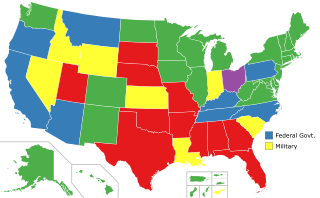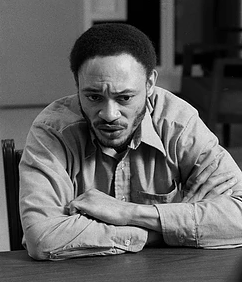Related Research Articles

In the United States, capital punishment is a legal penalty throughout the country at the federal level, in 27 states, and in American Samoa. It is also a legal penalty for some military offenses. Capital punishment has been abolished in 23 states and in the federal capital, Washington, D.C. It is usually applied for only the most serious crimes, such as aggravated murder. Although it is a legal penalty in 27 states, 20 states have the ability to execute death sentences, with the other seven, as well as the federal government, being subject to different types of moratoriums.

In the U.S. state of California, capital punishment is a legal penalty. However it is not allowed to be carried out as of March 2019, because executions were halted by an official moratorium ordered by Governor Gavin Newsom. Before the moratorium, executions had been frozen by a federal court order since 2006, and the litigation resulting in the court order has been on hold since the promulgation of the moratorium. Thus, there will be a court-ordered moratorium on executions after the termination of Newsom's moratorium if capital punishment remains a legal penalty in California by then.
Robin McKennel Lovitt is a convicted murderer in the U.S. state of Virginia. He was sentenced to death, after being convicted of the November 18, 1998 stabbing murder of Clayton Dicks in Arlington County, Virginia. Lovitt was granted clemency by Virginia Governor Mark R. Warner on November 29, 2005, the day before he was scheduled to be executed by lethal injection at the Greensville Correctional Center.

Capital punishment is a legal penalty in the U.S. state of Texas for murder, and participation in a felony resulting in death if committed by an individual who has attained or is over the age of 18.
Capital punishment was abolished in Virginia on March 24, 2021, when Governor Ralph Northam signed a bill into law. The law took effect on July 1, 2021. Virginia is the 23rd state to abolish the death penalty, and the first southern state in United States history to do so.
Green Haven Correctional Facility is a maximum security prison in New York. The prison is located in the Town of Beekman in Dutchess County. The New York State Department of Corrections and Community Supervision lists the address as Route 216, Stormville, NY 12582. This prison housed New York's execution chamber during the time the state briefly had the death penalty in the post-Furman era. It was originally a federal prison and now houses maximum security inmates. Green Haven Correctional Facility also operated a Hot Kosher Foods Program; but no longer does as of 2020. However, because of this, the prison had a large Jewish population. Yale Law School operates the Green Haven Prison Project, a series of seminars among Yale law students and Green Haven inmates on law and policy issues concerning prisons and criminal law.

Potosi Correctional Center (PCC) is a Missouri Department of Corrections prison located in unincorporated Washington County, Missouri, near Mineral Point. The facility currently houses 800 death row, maximum security and high-risk male inmates.

The Virginia Department of Corrections (VADOC) is the government agency responsible for community corrections and operating prisons and correctional facilities in the Commonwealth of Virginia in the United States. The agency is fully accredited by the American Correctional Association and is one of the oldest functioning correctional agencies in the United States. Its headquarters is located in the state capital of Richmond.

Morris Odell Mason was an American convicted rapist and murderer who called himself "the killer for the Eastern Shore". He was executed for the murder of Margaret K. Hand, although he was responsible for at least one other murder committed during a killing spree days prior that involved multiple burglaries and sexual assaults. His execution was controversial due to his diagnosis with schizophrenia and developmental disabilities, the latter of which caused activists and even Mason's executioner to worry that Mason was not mentally sound enough to be aware of his impending execution.

William Charles Morva was an American-Hungarian man convicted of the 2006 shooting deaths of Sheriff's Deputy Corporal Eric Sutphin, 40, and hospital security guard Derrick McFarland, 32, in the town of Blacksburg, Virginia. He was sentenced to death for the crime and was executed on July 6, 2017. Morva was the last inmate to be executed by the Commonwealth of Virginia before capital punishment in the state was abolished on March 24, 2021.
Capital punishment was abolished in Colorado in 2020. It was legal from 1974 until 2020 prior to it being abolished in all future cases.
Death row, also known as condemned row, is a place in a prison that houses inmates awaiting execution after being convicted of a capital crime and sentenced to death. The term is also used figuratively to describe the state of awaiting execution, even in places where no special facility or separate unit for condemned inmates exists. In the United States, after an individual is found guilty of a capital offense in states where execution is a legal penalty, the judge will give the jury the option of imposing a death sentence or life imprisonment without the possibility of parole. It is then up to the jury to decide whether to give the death sentence; this usually has to be a unanimous decision. If the jury agrees on death, the defendant will remain on death row during appeal and habeas corpus procedures, which may continue for several decades.
Earl Washington Jr. is a former Virginia death-row inmate, who was fully exonerated of murder charges against him in 2000. He had been wrongfully convicted and sentenced to death in 1984 for the 1982 rape and murder of Rebecca Lyn Williams in Culpeper, Virginia. Washington has an IQ estimated at 69, which classifies him as intellectually disabled. He was coerced into confessing to the crime when arrested on an unrelated charge a year later. He narrowly escaped being executed in 1985 and 1994.
Richard Eugene Glossip is an American prisoner currently on death row at Oklahoma State Penitentiary after being convicted of commissioning the 1997 murder of Barry Van Treese. The man who murdered Van Treese, Justin Sneed, had a "meth habit" and agreed to plead guilty in exchange for testifying against Glossip. Sneed received a life sentence without parole. Glossip's case has attracted international attention due to the unusual nature of his conviction, namely that there was little or no corroborating evidence, with the first case against him described as "extremely weak" by the Oklahoma Court of Criminal Appeals.
Raymond George Riles is an American convicted murderer who was on death row in Texas from 1976 until he was resentenced to life imprisonment in June 2021. At the time of his resentencing, Riles had been on death row longer than anyone else in the United States. He was convicted of the December 1974 capital murder of John Henry, a Houston used car salesman. Riles was ruled competent to stand trial in the 1970s, but while on death row he was repeatedly found to be too mentally ill to execute.

Susan Marie Deans was an American anti-death penalty activist who was committed to finding attorneys for men who were facing execution without legal representation. Marie's work began on death row began in South Carolina in the early 1980s and continued in Virginia for the next twenty years where she won reduced sentences for over 200 death-row inmates in Virginia and South Carolina. A memoir of Deans' life and work, titled A Courageous Fool: Marie Deans and Her Struggle Against the Death Penalty, was released in 2017.
Madison v. Alabama, 586 U.S. ___ (2019), was a United States Supreme Court case regarding the Eighth Amendment to the United States Constitution, barring cruel and unusual punishment. The case deals with whether the Eighth Amendment prohibits executing a person for a crime they do not remember.

Julius Darius Jones is an American prisoner and former death row inmate from Oklahoma who was convicted of the July 1999 murder of Paul Howell. His case has received international attention due to claims of innocence and controversy surrounding his trial and conviction. Jones was convicted of the crime on the basis of what the Oklahoma Court of Criminal Appeals later characterized as an "overwhelming" body of evidence consisting of "a co-defendant who directly implicated Jones, eyewitness identification, incriminating statements made by Jones after the crime, flight from police, damning physical evidence hidden in Jones's parents' home, and an interlocking web of other physical and testimonial evidence consistent with the State's theory."

Wilbert Lee Evans was an American convict who was executed in Virginia's electric chair for the murder of 47-year-old deputy sheriff William Gene Truesdale in Alexandria, Virginia. Truesdale's murder occurred in 1981 during Evans's attempted escape from custody, as Evans was accused of separate crimes in North Carolina and had been temporarily transported to Virginia to testify in another man's extradition hearing there.
References
- ↑ "Former Virginia death row inmate granted parole". Richmond Times-Dispatch. Associated Press. June 21, 2017. Retrieved June 21, 2017– via WMAR-TV.
- ↑ "Giarratano v. Com". Justia Law. Retrieved March 11, 2022.
- ↑ "Wilder Commutes Death Sentence", from The Washington Post, printed also in Los Angeles Times, February 20, 1991; accessed June 2, 2017
- ↑ "TERRY SAYS NO TO GIARRATANO". The Roanoke Times. February 21, 1991. Retrieved February 2, 2024.
- 1 2 3 4 5 6 Margolick, David (March 5, 1990). "Legal Scholar on Death Row Fights to Halt Own Execution". The New York Times. Retrieved June 16, 2012.
- 1 2 3 Frank Green, "Inmate has come a long way since 1979 sentence", Richmond Times-Dispatch, December 7, 1997, at Truth in Justice website; accessed June 2, 2017
- ↑ Colman McCarthy. Op-Ed: "More than a Reasonable Doubt", The Washington Post (opinion piece), February 16, 1991
- 1 2 [the state forensic lab admitted that biological evidence had been retained for possible future testing, but that they could not locate it, i.e. that it was lost, but not destroyed. Transcript of hearing available at freejoeg.com.tp://truthinjustice.org/giarratano2.htm Bill Geroux, "Judge isn't sure Giarratano evidence exists"], Richmond Times-Dispatch, January 22, 2004, at Truth in Justice website; accessed June 2, 2017
- ↑ "Representation in Capital Cases". Capital Punishment in Context. Retrieved June 16, 2012.
- ↑ Vollers, Maryanne (May 28, 1990). "As His Date with the Executioner Nears, Joe Giarratano Says He's No Killer—and Some People Believe Him". People . Retrieved June 16, 2012.
- ↑ "Va. death row inmate tried it a second time". The Free Lance-Star. November 30, 1985. p. 13. Retrieved June 16, 2012.
- 1 2 (June 2012) "Earl Washington" University of Michigan Law School, The National Registry of Exonorations, Retrieved November 14, 2014
- ↑ Bearss, Sara. "Virginia Libraries v50n1 - Virginia Reviews". Margaret Edds. An Expendable Man: The Near-Execution of Earl Washington Jr. New York and London: New York University Press, 2003. Archived from the original on December 24, 2013. Retrieved June 16, 2012.
- ↑ Jebb, John F. (2011). True Crime: Virginia: The State's Most Notorious Criminal Cases. Stackpole Books. ISBN 9780811745123.
- ↑ McCarthy, Colman. I'd Rather Teach Peace. Orbis Books, 2002, pp. 95–110